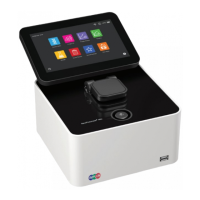NanoPhotometer
®
N120/NP80/N60/N50/C40 User Manual Version 4.3.1
70
PROTEIN UV
METHOD OVERVIEW
The Protein UV method exploits the inherent absorbance of proteins at 280 nm in
combination with the Beer-Lambert Law, where each protein is characterized by a protein
specific extinction coefficient (ε) which can be used to determine total protein concentration
of a solution. The intrinsic absorbance of proteins is due to the presence of aromatic amino
acids in their structure, primarily tryptophan and tyrosine, as well as cysteine (oxidized
cysteine residues in a disulphide bond). The aromatic amino acid residues in a protein
containing tryptophan and tyrosine exhibit strong intrinsic absorbance at 280 nm, with a
lesser contribution by phenylalanine. Therefore, it is the aromatic amino acid residues which
dictate the extinction coefficient at 280 nm for a protein.
The most straightforward method to determine concentration of a purified, homogenous
protein with a known extinction coefficient (ε) is by direct measurement of UV280 provided
as long as the protein contains no prosthetic groups with strong absorption in the same
region. However, for unknown proteins including homogenous protein mixtures, it is possible
to make direct A
280
measurements using a composite ε value derived from comparison of
many proteins, although this will only provide an approximate but close estimate of the true
protein concentration.
The NanoPhotometer
®
determines protein concentration by performing calculations based
on specific ε values, either pre-programmed in the instrument or entered manually by the
user. Extinction coefficient (ε) values at 280 nm vary greatly for different proteins due to their
particular aromatic amino acid content. Fixed ε values are pre-programmed in the software
for certain proteins (see Table 3 on page 79). However, if the protein of interest is not
included in the pre-programed methods it is also possible to manually enter the specific ε for
the protein of interest using the custom Mol. Ext. Coefficient, custom Ext. Coefficient or
custom 1/Ɛ protein factor option. For correct calculation, it is necessary to supply either: a)
the molar extinction coefficient (ε
M
in M
-1
*cm
-1
) and the molecular weight expressed in molar
mass units (g/mol); b) the mass extinction coefficient (ε in l/g*cm) or c) the protein factor 1/Ɛ
of the protein.
To determine the degree of dye labelling of a protein, the absorbance measured at the
wavelength corresponding to the absorbance maximum of the fluorescence dye is used (see
Table 3 on page 79). The corresponding extinction coefficient of the dye is used along with
the Beer-Lambert Law to determine the dye concentration.
Note: It is important to ensure the extinction coefficient and units entered are correct in order
to ensure that calculations are performed properly for accurate concentration values.
Sample Control™ gives useful information about air bubbles, sample impurities, turbidity, lint
residues and potential contaminations. If the Sample Control™ detects any inconstancy an
alert icon is shown in the result/table area. A push on the alert icon shows additional
information about the inconstancy.

